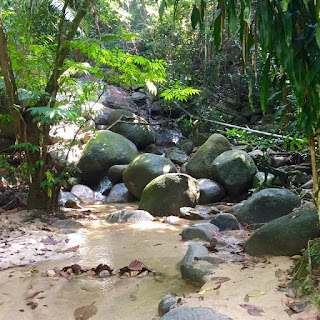LETTER TO THE EDITOR
HALT LOGGING IN VICINITY OF FOREST RESERVES
It is with grave concern that environmentalists and conscientious citizens read how state and forestry authorities rationalise logging activities in Batu Yon and land surrounding the Merapoh Forest Reserve in the Kuala Lipis area by claiming that the logging is carried out in land owned by the Agriculture Industrial Development Board (LKPP) and not directly on the forest reserve land.
The Merapoh forest, estimated to be 130 million years old, is home to endangered species which include elephants, tigers, tapirs, sun bears and deer, as well as rare flora such as the rafflesia. Its spectacular limestone caves form a vital part of Malaysia’s natural heritage. All of these natural wonders are now under threat as a result of logging and roadworks in their vicinity.
The fact remains that agricultural land bordering gazetted forest reserves are still critical water catchment areas and wildlife habitats. It is overly simplistic to claim that agricultural, recreational or rural residential areas bordering forest reserves are fair game for logging and development since they do not constitute the forest reserve land proper.
Opening up logging roads into areas surrounding forest reserves has knock-on effects and can and do affect the forest reserve area adversely. Statistical evidence has shown that logging roads everywhere from Russia to Central Africa and Southeast Asia have increased access for poachers and hunters into sensitive wildlife habitats and also increased the incidence of human-wildlife conflict and roadkill.
In fact, timber companies operating in areas such as the Primorsky Krai in Russia where serious decline in wildlife populations has been recorded since the opening up of logging roads are under great pressure to close up logging roads and carry out mitigation measures.
Sadly, here in Southeast Asia where up to 48% of all native mammal species are predicted to be extinct by 2100, roads continue to be opened up for logging and mining or for ‘transporting forest products’, despite the irrefutable data that forested land is worth much more intact than when depleted, logged or converted into plantations. The economic benefits of logging are short-lived and can sustain only 1-2 generations at most.
Not only are the Merapoh Caves a sensitive wildlife habitat, they are also an important ecotourism site. Logging and deforestation in the areas surrounding the Merapoh Caves will have a severe negative impact on the rural communities whose livelihood depend on ecotourism and subsistence farming and fishing in areas that are now polluted, depleted and exposed.
Apart from the threat it poses to wildlife populations, logging and deforestation also affect air quality, climate and water cycle patterns. Healthy forests absorb solar energy and release water vapour, while forest clearing releases stored carbon dioxide, which traps heat and contributes to atmospheric warming.
The destruction of watershed areas will result in more flash floods, landslides and drought, thus costing the State and Federal Governments more in disaster management and mitigation than they are able to benefit from issuing permits for logging, mining and agricultural activities.
The growing number of environmental and citizens’ action groups in Malaysia calling for an end to deforestation and for the protection of the Merapoh Caves and forest reserve attests to the growing awareness of our interconnectedness with our natural environment and the importance of forests for the ecosystem services they provide. It is not merely fear for the loss of income from trekking and ecotourism activities that motivates concerned citizens to speak up. The Merapoh Caves and forest reserve were here long before the existence of humans. We cannot afford to lose any more of it in our age of collapsing ecosystems and anthropogenic disasters.
WONG EE LYNN
COORDINATOR,
GREEN LIVING SPECIAL INTEREST GROUP,
MALAYSIAN NATURE SOCIETY






































































